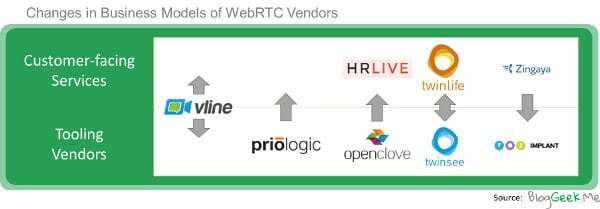We reached the point in time, where “show me the money” is becoming important enough.
There is a lot of talk around the web about the advantages and challenges of WebRTC. People tend to focus on this obvious part – the technical sides of WebRTC. It is easy to deal with as it is quantifiable in nature. For me that is an easy “mistake” to make as well – as an engineer at heart, diving into technical details is something I love.
But the truth of the matter is, that WebRTC makes dealing with real time communications so much easier than it used to be, that the whole point of debating technical merits is moot. It is required when you get down to the drawing board to design and then develop whatever it is you want, but it is a familiar process.
Now that the barrier of entry has been reduced to shreds by WebRTC, the question is – how do you make money out of it? The truth is that for the most part, money won’t be made in WebRTC, but rather on the use case that is built on top of it.
Now that I am tracking 250 vendors and services, I am starting to look at more aspects of these vendors – one of the things I am starting to look at is business models – to see how different vendors plan (or already are) making a living from WebRTC.
I think we are now in a transition stage: we know what WebRTC, we know what it can do, we’ve seen the nice demos and concepts that use it, and now it is time to think of how to monetize it.

Here are 5 different vendors who are searching for the best business model they can find:
Zingaya
Zingaya is a vendor I have interviewed recently. My main interest was their shift from offering a calling service for websites into API platforms, with the introduction of VoxImplant. This marks them as a vendor shifting from Services into Tooling.
Priologic
Priologic (interview here) is a Canadian software house that is now adding WebRTC into its war chest of capabilities.
They have started with their easyRTC platform for developers, and have added on top of it the great Tawk.com service (I am enjoying it since I tried it many months ago). While Tawk.com can be seen as an example of how easyRTC can be used, it is a fully functioning service that can stand on its own. Will Priologic end up finding itself focusing more on Tawk.com than the original easyRTC platform or not is yet to be seen.
Twinlife and Twinsee
No interview yet. These are two services coming from France.
Twinlife is focused on a service connecting family members across generations via video calling, while Twinsee is the API platform it is written on top. Which came first is unknown to me, but again we see this double-headed approach of offering a full service to end customers coupled with a tooling vendor play.
vLine
vLine started as a video conferencing platform that can be embedded with an enterprise’ internal systems. Through time, it has shifted slightly to offering vLine for Developers – its API platform.
And then 2 weeks ago, it announced vLine Link – an ad hoc video calling service that generates a random URL that can be shared to open up a video conference.
In a way, vLine is dogfooding here as I assume they have built this service on top of their own API platform.
OpenClove
OpenClove (yes, here’s an interview) have started life as an API platform for developers. It just launched its own targeted service: HRLive, a recruiting service for enterprises.
–
Where are we headed with it?
A year or two down the road, many tooling vendors will need to either get to a point where they are large enough with a mass of developers in their ecosystem, or find another route to money – and that route is probably going to be offering their own unique service to end customers.

Hello Tsahi and thanks for this informative blog. I am currently investigating backed technologies that would make the WEbRTC experience better above 4 users. Either on the end user side, since degradation is based on the configuration of the end user CPU, and the servers since since I understand that some (Tox-Bpx and Vline) vendors have switching capabilities that handle the video session cleaner for the end user. Are you aware of some of the back end/switching capabilities that I could look into so that more then 4 users can have a conference?
Emailing me direct would be great if you can. Thanks
Chris Williams